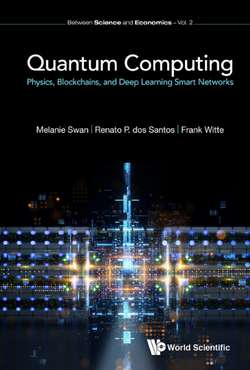Читать книгу Quantum Computing - Melanie Swan - Страница 9
На сайте Литреса книга снята с продажи.
ОглавлениеList of Tables
Table 2.1.Early smart networks (Smart Networks 1.0)
Table 2.2.Robust self-operating smart networks (Smart Networks 2.0)
Table 2.3.Quantum smart networks (Future-class Smart Networks 3.0)
Table 2.4.Smart networks by operational focus
Table 2.5.Steps in articulating an effective field theory
Table 3.1.Quantum computing hardware platforms
Table 3.2.Superconducting materials
Table 3.3.Qubit types by formation and control parameters
Table 4.1.Quantum applications and number of qubits required
Table 4.2.Church–Turing computability thesis
Table 4.3.Quantum computing systems and error correction
Table 4.4.Interpretations of Bell’s inequality
Table 5.1.Computational trust model comparison and progression
Table 5.2.Economic themes with instantiations in blockchain networks
Table 6.1.Roadmap: Six steps to a quantum internet
Table 7.1.Comparison of zero-knowledge proof systems
Table 7.2.Transaction systems comparison: Confidentiality and anonymity
Table 11.1.Key aspects of statistical neural field theory
Table 11.2.Statistical neural field theory: System norm and criticality
Table 11.3.Obtaining a master field equation for the neural system
Table 11.4.Expanding the Markov random walk to a Markov random field
Table 11.5.Linear and nonlinear models of the system action
Table 11.6.Statistical neural field theory system criticality
Table 11.7.Key aspects of the spin-glass model
Table 11.8.Spin-glass model: System norm and criticality
Table 12.1.SNFT: Minimal elements
Table 12.2.SNFT: Particles and interactions
Table 12.3.SNFT: System operating parameters
Table 12.4.Operating parameters in smart network systems
Table 12.5.System criticality parameters in smart network systems
Table 12.6.Blockchain network services provided by peer-to-peer nodes
Table 12.7.Deep learning services provided by perceptron nodes
Table 13.1.Key historical moments in the AdS/CFT correspondence
Table 13.2.Tools and methods used in AdS/CFT correspondence research
Table 14.1.Examples of holographic quantum error-correcting codes
Table 14.2.Quantum information science topics
Table 15.1.SNQFT: Minimal elements
Table 15.2.Natural security features built into quantum mechanical domains
Table 15.3.Examples of bulk–boundary directional transformations
Table 15.4.Examples of bulk–boundary correspondence relationships
Table 15.5.Long-distance and short-distance descriptions in field theory systems
Table 15.6.Eras in quantum computing, physical theory, and smart networks
